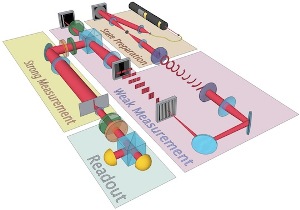Jan 21 2014
Until recently measuring a 27-dimensional quantum state would have been a time-consuming, multistage process using a technique called quantum tomography, which is similar to creating a 3D image from many 2D ones. Researchers at the University of Rochester have been able to apply a recently developed, alternative method called direct measurement to do this in a single experiment with no post-processing.
 A schematic of the experimental setup using a HeNe laser, lenses, beam-splitters, wave-plates, a fan-out hologram and other tools. Light can be thought of as a spiral and the orbital-angular-momentum quantum number describes how “twisted” this spiral is. The weak measurement setup shows how this spiral is "untwisted" before it is measured. Credit: M. Malik/Nature Communications'
A schematic of the experimental setup using a HeNe laser, lenses, beam-splitters, wave-plates, a fan-out hologram and other tools. Light can be thought of as a spiral and the orbital-angular-momentum quantum number describes how “twisted” this spiral is. The weak measurement setup shows how this spiral is "untwisted" before it is measured. Credit: M. Malik/Nature Communications'
The work is of interest because fast, accurate and efficient methods for characterizing high-dimensional states like this could be central in developing high security quantum communications systems, as well as to probe our fundamental understanding of quantum mechanics.
The work was published this week in Nature Communications by a team of researchers from the University of Rochester and the University of Glasgow. In the paper they demonstrate direct measurements of the quantum state associated with the orbital-angular momentum.
“Our work shows that direct measurement offers an exciting alternative to quantum tomography,” said Robert Boyd, Professor of Optics and Physics at the University of Rochester and Canada Excellence Research Chair in Quantum Nonlinear Optics at the University of Ottawa. “As the field of quantum information continues to advance, we expect direct measurement to play an increasingly important role in this.” Boyd added that although it is unclear exactly how much more efficient direct measurement is compared to quantum tomography, the lack of post-processing is a major factor in speeding-up direct measurements.
The direct measurement technique offers a way to directly determine the state of a quantum system. It was first developed in 2011 by scientists at the National Research Council Canada, who used it to determine the position and momentum of photons. Last year, a group of Rochester/Ottawa researchers led by Boyd showed that direct measurement could be applied to measure the polarization states of light. The new paper is the first time this method has been applied to a discrete, high dimensional system.
Such direct measurements of the wavefunction might have appeared to be ruled out by the uncertainty principle – the idea that certain properties of a quantum system could be known with precision only if other properties were known poorly. However, direct measurement involves a "trick" that makes it possible.
Direct measurements consists of two types of measurements performed one after the other, first a “weak” measurement followed by a “strong” measurement. In quantum mechanics the act of measuring a quantum state disturbs it irreversibly, a phenomenon referred to as collapse of the wavefunction. The trick lies with the first measurement being so gentle that it only slightly disturbs the system and does not cause the wavefunction to collapse.
“It is sort of like peeking into the box to see if Schrodinger’s cat is alive, without fully opening the box,” said lead author Dr. Mehul Malik, currently a post-doctoral research fellow at the University of Vienna and who was a Ph.D. in Boyd’s group when the work was performed. “The weak measurement is essentially a bad measurement, which leaves you mostly uncertain about whether the cat is alive or dead. It does, however¬, give partial information on the health of the cat, which when repeated many times can lead to near certain information as to whether the cat is alive or dead.” Malik adds that the beauty of the weak measurement is that it does not destroy the system, unlike most standard measurements of a quantum system, allowing a subsequent measurement—the “strong” measurement of the other variable.
This sequence of weak and strong measurements is then repeated for multiple identically prepared quantum systems, until the wave function is known with the required precision.
Ph.D. student Mohammad Mirhosseini was also part of the Rochester team. Other collaborators included Professor Miles Padgett and Martin Lavery from the University of Glasgow, UK, and Dr. Jonathan Leach, from Heriot-Watt University, Edinburgh, UK.
The DOI for this paper will be 10.1038/ncomms4115. Once the paper is published, it will be available to view online at http://www.nature.com/naturecommunications.
About the University of Rochester
The University of Rochester (www.rochester.edu) is one of the nation’s leading private universities. Located in Rochester, N.Y., the University gives students exceptional opportunities for interdisciplinary study and close collaboration with faculty through its unique cluster-based curriculum. Its College, School of Arts and Sciences, and Hajim School of Engineering and Applied Sciences are complemented by its Eastman School of Music, Simon School of Business, Warner School of Education, Laboratory for Laser Energetics, School of Medicine and Dentistry, School of Nursing, Eastman Institute for Oral Health, and the Memorial Art Gallery.